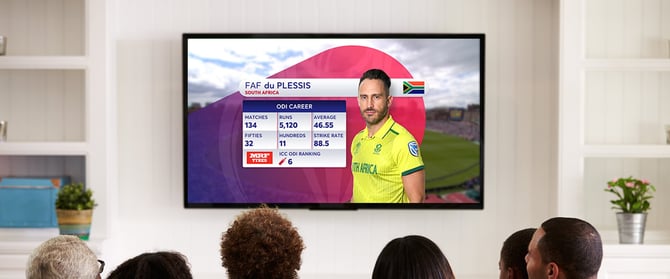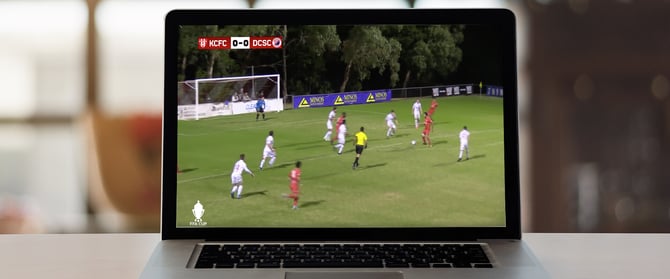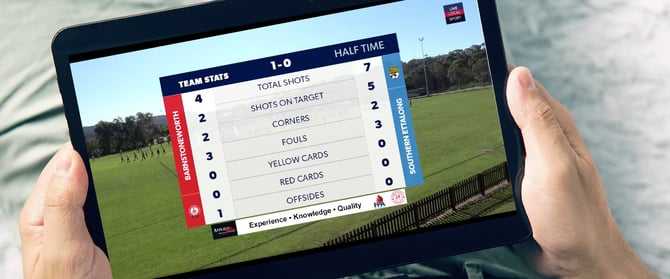.png?width=1170&name=Image%20from%20iOS%20(8).png) The enjoyment of a live sports broadcast is dependent on three key components: live video of the on-field play, commentary, and in-game statistics.
The enjoyment of a live sports broadcast is dependent on three key components: live video of the on-field play, commentary, and in-game statistics.
The live sports graphics landscape
You probably take it for granted, but the enjoyment of a live sports broadcast is dependent on three key components: live video transmission of the on-field play, commentary, and in-game statistics such as the score, game time and countless other data-points.
For big budget televised sports, these three components have been solved to a very high level. Multiple camera angles allow forensic analysis of instant replays and live broadcast infrastructure beams high-definition action around the world. Audio from the commentary team inside the stadium is added to the video feed, as well as sideline commentary and analysis. Every break in play is filled with real time statistics that enhance the viewing experience and tell the story of the game.
 Player statistic graphics shown on cricket TV broadcast. Credit: AEG.
Player statistic graphics shown on cricket TV broadcast. Credit: AEG.
For video and commentary, the democratization of web-based live streaming platforms and protocols like YouTube and RTMP have allowed lower-level live stream broadcasts to deliver a comparable experience to televised sport. These are now solved problems with familiar, straightforward workflows and established technology – but live graphics are a completely different ballgame. As yet, there hasn’t been a similar revolution to bring TV-quality in-game statistics to grassroots broadcasts. Without this technology, storytelling is severely hampered.
A decade ago in the early days of live-streamed sports, video and commentary were acceptable from the start, but the quality of the graphics always lagged a long way behind. It usually went as far as showing the score, and maybe a clock if you were lucky. Stats? Animation? Sponsorship other than a boxy logo in the corner? No chance.
 Simple graphics on a live stream, shown on a laptop.
Simple graphics on a live stream, shown on a laptop.
Fast forward to today, and nothing has changed for the majority of live-streamed sport. Delivering anything but the most basic match stats has proved impossible for grassroots broadcasters with lower-level budgets, fewer resources and less knowledgeable producers. A lack of deeper-level in-game statistics is still the biggest problem for live stream broadcasters – and the biggest point of difference between watching professional sport on TV and grassroots sport online. Sports fans have grown up on a diet of beautifully presented statistical information on TV, so it’s natural that games without graphics and stats just feel flat in comparison.
Putting the viewer experience aside for a moment, it’s arguable that this is the biggest issue facing live streamed sports at the grassroots level. Why? Advertising dollars and sponsorships are how sports teams are funded. TV networks pay billions for the rights to show NFL or NBA games. They do this because it makes financial sense. Popular sports mean a guaranteed audience of subscribers, and big brands pay the TV networks millions to sponsor their live sports broadcast and show their ads.
The financial model should be no different for lower-league live sports broadcasters. The problem is, until now, it has been impossible to integrate sponsors into live-streamed sports in a professional, effective, trackable way. The LIGR.Live platform makes all this possible and more – but we’ll cover that in more detail later in this series of posts.
First, I want to explain a few things that will help you to understand why putting graphics on a live stream is so difficult – and why it’s so important.
Why Live Graphics are Impossible for Sub-Elite Sports Broadcasts
As live streaming has become more popular and affordable, the need for an economical, high-quality, professional graphics solution has also grown. All too often, smaller sporting organizations and production companies struggle to make it work with limited resources. Traditional solutions are unrealistic; affordable ones are unprofessional. Teams and broadcasters lose out on revenue-producing opportunities, and fans miss out on engaging, storytelling content.
For small teams, clubs, or schools, it’s prohibitively expensive to hire a production company to produce sophisticated in-game graphics. Traditional hardware and software are expensive, require highly skilled, experienced operators and they aren’t really suited to live stream broadcasting. (The new age of live streaming isn’t about a huge team working behind the scenes putting everything into broadcasting one game perfectly. It’s about a small team delivering 100 games at 80% quality, in a way that’s financially sustainable.) Then, add a design team to create the graphics and you’ve got mounting costs to cover. I can’t stress enough how costly it is to staff an ESPN-level sports broadcast. It just doesn’t make sense to use existing broadcast industry technology and workflows for live-streamed sport.
To make in-game data and graphics accessible for grassroots broadcasting, all design work, skilled graphics operation, and data integration must be completely taken out of the equation. If these can’t be removed from the workflow and fully automated, then it will forever be out of reach for these sports teams.
There is affordable technology available for grassroots sports broadcasters, but they are all severely lacking in the graphics department. At LIGR, we understand the true value of graphics and statistics, and the importance of the sponsorship opportunities that our cloud graphics platform brings to live-streamed grassroots sport. It’s easy to overlook at this level – maybe because there is a stigma about single-camera live streams and a belief that audience numbers are too low to bother with statistics, graphics and advanced advertising platforms. If you only think about one-off games, this is probably true, but the real value of grassroots sport is in aggregated content. Consider the fact that, every year, there are more than 8 million highly-competitive high school games played in the US. If each of those games only attract a modest audience of 50 viewers – which is guaranteed with family and alumni – that’s an audience of 400 million, just for high school sport.
Although, viewer numbers do not tell the whole story with grassroots sports. It’s not so much about the size of the audience, it’s more about who is watching. Local sports are built on passion, tribalism and localization. Sports fans who went to high school or college follow their teams for life, probably even more passionately than they follow city-based professional teams. The people that watch grassroots live-streamed sport care very deeply about their teams – even if they are the only ones watching.
Graphics, Data and Local Sports Sponsorship
Who is watching and engaging with local sports content matters to advertisers and sponsors.
These aren’t global conglomerates that need to reach a mass-market audience. Local sport attracts local advertisers. These businesses are all about community, goodwill and engaging with the local neighbourhood. Viewing figures are not the priority, these brands want to support their local teams and convert fans into customers in return. They also appreciate it when you can provide evidence that their sponsorship creates value for their business.
 LIGR graphics being used on a local football live stream, showing local sponsors.
LIGR graphics being used on a local football live stream, showing local sponsors.As a local sports team, if you can integrate professional TV-quality advertising into your live streams, it will put your sponsors up in lights and form a strong connection with your team in the minds of the audience. This is a big step up for businesses that are used to seeing their logo on a team’s physical billboards. Using the LIGR.Live platform to strategically connect sponsors with match events such as goals, baskets, and touchdowns takes their advertising to the next level and builds significant brand value.
If you would like to find out more about how in-game event sponsorship works, we’ll be publishing a series of blog posts soon that covers the finer details of the monetization and sponsorship of live sport.
If you want to take a deep dive into live graphics for sports, jump over to our blog piece on the
History of Live Graphics - The evolution of live graphics technology.In the remainder of our
Live Graphics Series we will breakdown the most important graphics in a sports broadcast, and how match statistics and data are integrated into each graphic and how sponsors can be integrated and displayed across productions.
First up, we’ll take a look at the
scorebug – the most important live sports graphic – and its role in telling the story of the game. We’ll also see how the scorebug can be used to deliver in-game stats and provide sponsorship opportunities.
The full list of graphics we will be breakdown are listed below. As we release each article, we will link the piece back to this post for easy navigation.
Live Graphics List:
FF = Full Frame
LT = Lower Third
.png?width=1170&name=Image%20from%20iOS%20(8).png) The enjoyment of a live sports broadcast is dependent on three key components: live video of the on-field play, commentary, and in-game statistics.
The enjoyment of a live sports broadcast is dependent on three key components: live video of the on-field play, commentary, and in-game statistics. Player statistic graphics shown on cricket TV broadcast. Credit: AEG.
Player statistic graphics shown on cricket TV broadcast. Credit: AEG.
